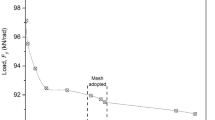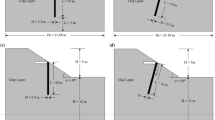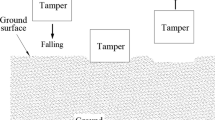Abstract
This study presents the results of a numerical investigation performed to investigate the behavior of a cantilever secant pile wall (CSPW) used to support excavation in sandy soil. These types of excavations have the potential to cause severe ground movement and possible damage to the adjacent structures. A major concern in supporting excavation is to predict and control ground movement associated with excavation particularly in cohesionless soils, as it could trigger global instability and catastrophic failure. The magnitude and distribution of lateral earth pressure and ground movement depend mainly on soil properties, excavation depth, excavation plan geometry, the stiffness of the supporting wall, and the contact between the secant piles themselves. Three-dimensional finite element model has been developed in this study to capture the excavation and wall geometry. A parametric study has been performed using a wide range of sand density, excavation depth, wall flexural stiffness, and bonding between piles within the wall. The results allowed for the development of an approach to predict both the wall deflection for the case of fully and partially bonded piles. This will help engineers to predict ground movement and select an appropriate supporting system that can maintain the stability of the adjacent structures.









Similar content being viewed by others
References
Achmus M, Thieken K, Saathoff J, Terceros M, Albiker J (2019) Un- and reloading stiffness of monopile foundations in sand. Applied Ocean Research. 84:62–73. https://doi.org/10.1016/j.apor.2019.01.001
Addenbrooke TI (1994) A flexibility number for the displacement controlled design of multi propped retaining walls. Journal of Ground Engineering. 27(7):41–45
Altuntas, C., Persaud, D., and Poeppel, A. R. (2009) Secant pile wall design and construction in Manhattan. Proc., Int. Foundation Congress and Equipment Expo (IFCEE2009), ASCE, Reston, VA, 105–112.
Bica AVD, Clayton CRI (1989) Limit equilibrium design methods for free embedded cantilever walls in granular materials. Proc. Instn Civ. Engrs Part 1 86. No. 5:879–989
Bica A, Clayton C (2004) An experimental study of the behaviour of embedded lengths of cantilever walls. Géotechnique. 48(6):731–745. https://doi.org/10.1680/geot.1998.48.6.731
Bolton MD (1986) The strength and dilatancy of sands. Géotechnique 36(1):65–78
Bolton MD, Powrie W (1987) Collapse of diaphragm walls retaining clay. Géotechnique, 37. No. 3:335–353. https://doi.org/10.1680/geot.1987.37.3.335
Bolton MD, Powrie W, Symons IF (1989) The design of stiff in-situ walls retaining overconsolidated clay, part I – short term behaviour. Ground Engng 22(8/9):34–47
Bolton MD, Powrie W, Symons IF (1990) The design of stiff in-situ walls retaining overconsolidated clay, part II -– long term behaviour. Ground Engng 23. No. 2:22–28
Brinkgreve R, Engin E, Engin H (2010) Validation of empirical formulas to derive model parameters for sands. In: Brinkgreve R, Engin E, Engin H (eds) 7th International Conference of Numerical Methods in Geotechnical Engineering. Trondheim, Norway. https://doi.org/10.1201/b10551-25
Bryson LS, Medina DG (2010) Finite element analyses of secant pile wall installation. Proc Inst Civ Eng, Geotech Eng 163(4):209–219
Bryson LS, Zapata-Medina DG (2012) Method for estimating system stiffness for excavation support walls. Journal of Geotechnical and Geoenvironmental Engineering. 138(9):1104–1115. https://doi.org/10.1061/(ASCE)GT.1943-5606.0000683
Burland JB, Potts DM, Walsh NM (1981) The overall stability of free and propped embedded cantilever retaining walls. Ground Engineering, 14. No. 5:28–37
Clough GW, O'Rourke T (1990) Construction induced movements of in situ walls. Proceedings of Design and performance of Earth Retaining Structures, ASCE Special Conference, Ithaca, New York, pp 439–470
Conte E, Troncone A, Vena M (2013) Nonlinear three-dimensional analysis of reinforced concrete piles subjected to horizontal loading. Comput. Geotech. 49:123–133
Conte E, Troncone A, Vena M (2015) Behaviour of flexible piles subjected to inclined loads. Comput. Geotech. 69:199–209
Conte E, Troncone A, Vena M (2017) A method for the design of embedded cantilever retaining walls under static and seismic loading. Géotechnique 67(12):1081–1089
Day RA (2001) Earth pressure on cantilever walls at design retained heights. Proc. Instn Civ. Engrs Geotech. Engng 149. No. 3:167–176
Dong YP, Burd HJ, Houlsby GT (2012) 3D FEM modelling of a deep excavation case history considering small-strain stiffness of soil and thermal contraction of concrete. In: Proceedings of the BGA Young Geotechnical Engineers’s Symposium. University of Leeds, Leeds, UK
Dong Y, Burd H, Houlsby G (2014) Advanced finite element analysis of a complex deep excavation case history in Shanghai. Front. Struct. Civ. Eng. 8:93–100. https://doi.org/10.1007/s11709-014-0232-3
Finno RJ, Bryson S (2002) Response of building adjacent to stiff excavation support system in soft clay. Journal of Performance of Constructed Facilities. 16(1):10–20. https://doi.org/10.1061/(ASCE)0887-3828(2002)16:1(10
Finno RJ, Bryson S, Calvello M (2002) Performance of a stiff support system in soft clay. J Geotech Geoenviron Eng 128(8):660–671. https://doi.org/10.1061/(ASCE)1090-0241(2002)128:8(660
Finno RJ, Tanner BJ, Roboski JF (2006) Three-dimensional effects for supported excavations in clay. Journal of Geotechnical and Geoenvironmental Engineering. 133(1). https://doi.org/10.1061/(ASCE)1090-0241(2007)133:1(30
Gannon J (2016) Primary firm secant pile concrete specification. Proceedings of the Institution of Civil Engineers - Geotechnical Engineering 169(2):110–120. https://doi.org/10.1680/jgeen.15.00038
Gaudin C, Garnier J, Thorel L (2004) Physical modelling of a cantilever wall. International Journal of Physical Modelling in Geotechnics 4(2):13–26
Gazetas G, Garini E, Zafeirakos A (2016) Seismic analysis of tall anchored sheet-pile walls. Soil Dynamics and Earthquake Engineering. 91:209–221. https://doi.org/10.1016/j.soildyn.2016.09.031
Ge X (2002) Response of a shield -driven tunnel to deep excavations in soft clay. PhD Thesis, Hong Kong University of Science and Technology.
Hashash Y (1992) Analysis of deep excavations in clay. Ph. D. Thesis, Massachusetts Institute of Technology, Dept. of Civil Engineering.
Hikooei BF (2013) Numerical modeling of pipe-soil interaction under transverse direction. Master’s thesis, University of Calgary, Calgary – Alberta, Canada
Hsiung B (2009) A case study on the behaviour of a deep excavation in sand. Computers and Geotechnics. 36(4):665–675. https://doi.org/10.1016/j.compgeo.2008.10.003
Hsiung B, Yang K, Aila W, Hung C (2016) Three-dimensional effects of a deep excavation on wall deflections in loose to medium dense sands. Computers and Geotechnics. 80:138–151. https://doi.org/10.1016/j.compgeo.2016.07.001
Hu ZF, Yue ZQ, Zhou J, Tham LG (2003) Design and construction of a deep excavation in soft soils adjacent to the Shanghai Metro tunnels. Canadian Geotechnical Journal. 40(5):933–948. https://doi.org/10.1139/t03-041
Jefferies M, Been K (2006) Soil liquefaction: a critical state approach. Taylor & Francis, Abingdon, UK
Ji X, Ni P, Zhao W, Yu H (2019) Top-down excavation of an underpass linking two large-scale basements in sandy soil. Arabian Journal for Geosciences 12:314. https://doi.org/10.1007/s12517-019-4493-y
Kenny S, Jukes P (2015) Pipeline/soil interaction modeling in support of pipeline engineering design and integrity. In: Oil and Gas Pipelines: Integrity and Safety Handbook, pp 99–142
Khoiri M, Ou C (2013) Evaluation of deformation parameter for deep excavation in sand through case histories. Computers and Geotechnics. 47:57–67. https://doi.org/10.1016/j.compgeo.2012.06.009
King GJW (1995) Analysis of cantilever sheet-pile walls in cohesionless soil. J. Geotech. Engng, ASCE 121(9):629–635
King G, McLoughlin J (1993) Centrifuge model studies of a cantilever retaining wall in sand. Retaining structures. ICE:711–720
Knappett J, Caucis K, Brown M, Jeffrey J, Ball J (2016) CHD pile performance: part II – numerical modelling. Proceedings of the Institution of Civil Engineers - Geotechnical Engineering. 169(5):436–454. https://doi.org/10.1680/jgeen.15.00132
Korff, M., Tol, A.F. van & Jong, E. de (2007) Risks related to CFA-pile walls. 14th European Conference on Soils (Mechanics and Geotechnical Engineering), Madrid - Spain.
Kung GT, Juang C, Hsiao E, Hashash Y (2007) Simplified model for wall deflection and ground-surface settlement caused by braced excavation in clays. Journal of Geotechnical and Geoenvironmental Engineering. 133(6):731–747. https://doi.org/10.1061/(ASCE)1090-0241(2007)133:6(731
Li AZ, Lehane BM (2010) Embedded cantilever retaining walls in sand. Géotechnique. 60(11):813–823. https://doi.org/10.1680/geot.8.P.147
Liao S-M, Li W-L, Fan Y-Y, Sun X, Shi Z-H (2014) Model test on lateral loading performance of secant pile walls. Journal of Performance of Constructed Facilities. 28(2):391–401. https://doi.org/10.1061/(ASCE)CF.1943-5509.0000374
Liu GB, Ng CW, Wang ZW (2005) Observed performance of a deep multistrutted excavation in Shanghai soft clays. Journal of Geotechnical and Geoenvironmental Engineering. 131(8):1004–1013. https://doi.org/10.1061/(ASCE)1090-0241(2005)131:8(1004)
Liu G, Jiang R, Ng C, Hong Y (2011) Deformation characteristics of a 38 m deep excavation in soft clay. Canadian Geotechnical Journal. 48(12):1817–1828. https://doi.org/10.1139/t11-075
Liu N, Duan N, Yu F (2018) Deformation characteristics of retaining structures and nearby buildings for different propped retaining walls in soft soil. Journal of Testing and Evaluation. 47(3):1829–1847. https://doi.org/10.1520/JTE20170763
Long M (2001) Database for retaining wall and ground movements due to deep excavation. Journal of Geotechnical and Geoenvironmental Engineering. 127(3):203–224. https://doi.org/10.1061/(ASCE)1090-0241(2001)127:3(203
Madabhushi G, Chandrasekaran VS (2005) Rotation of cantilever sheet pile walls. J Geotech Geoenviron. Eng 131:202–212
Madabhushi SPG, Zeng X (2006) Seismic response of flexible cantilever retaining walls with dry backfill. Geomech. Geoengng 1. No. 4:275–289
Martinkus V, Norkus A, Mikolainis M (2017) Numerical simulation of displacement model pile test performed in artificial sand deposit. Procedia Engineering. 172:715–722. https://doi.org/10.1016/j.proeng.2017.02.091
Mei GX, Chen QM, Song LH (2009) Model for predicting displacement-dependent lateral earth pressure. Can. Geotech. J. 46(8):969–975
Milligan G, St John H, O'Rourke H (2008) Contributions to Géotechnique 1948–2008: Retaining structures. Géotechnique. 58(5):377–383. https://doi.org/10.1680/geot.2008.58.5.377
Mohamad H, Soga K, Pellew A, Bennett P (2011) Performance monitoring of a secant-piled wall using distributed fiber optic strain sensing. J Geotech Geoenviron Eng 137(12). https://doi.org/10.1061/(ASCE)GT.1943-5606.0000543
Moormann C (2004) Analysis of wall and ground movements due to deep excavations in soft soil based on a new worldwide database. Soils And Foundations. 44(1):87–98. https://doi.org/10.3208/sandf.44.87
Ng C, Hong Y, Liu G, Liu T (2012) Ground deformations and soil–structure interaction of a multi-propped excavation in Shanghai soft clays. Géotechnique. 62(10):907–921. https://doi.org/10.1680/geot.10.P.072
Ng CWW, Shi J, Mašín D, Sun H, Lei GH (2015) Influence of sand density and retaining wall stiffness on three-dimensional responses of tunnel to basement excavation. Can. Geotech. J. 52(11):1811–1829. https://doi.org/10.1139/cgj-2014-0150
Nie D (2019) Analysis on the effect of excavation by sections for large foundation pit without horizontal struts. In: International Symposium for Intelligent Transportation and Smart City (ITASC) 2019 Proceedings. ITASC 2019. Smart Innovation, Systems and Technologies, vol 127. Springer, Singapore
Nikolinakou M, Whittle A, Savidis S, Schran U (2011) Prediction and interpretation of the performance of a deep excavation in berlin sand. Journal of Geotechnical and Geoenvironmental Engineering. 137(11):1047–1061. https://doi.org/10.1061/(ASCE)GT.1943-5606.0000518
Osouli A, Hashash Y (2010) Case studies of prediction of excavation response using learned excavation performance. International Journal of Geoengineering Case Histories. 1(4):340–366
Ou CY (2006) Deep excavation: theory and practice. Taylor & Francis, Netherlands
Ou C, Hsieh P, Chiou D (1993) Characteristics of ground surface settlement during excavation. Canadian Geotechnical Journal 30(5):758–767. https://doi.org/10.1139/t93-068
Ou C-Y, Hsieh P-G, Chiou D-C (2010) Characteristics of ground surface settlement during excavation. Canadian Geotechnical Journal. 30(5):758–767. https://doi.org/10.1139/t93-068
Panagoulias S, Hosseini S, Brinkgreve R (2018) An innovative design methodology for offshore wind monopile foundations. 26th European Young Geotechnical Engineers Conference, Graz. Austria.
PLAXIS 3D FOUNDATION (2006) Version 1.5 PLAXIS finite element code for soil and rock analysis. Delft University of Technology & PLAXIS B. V, Delft.
Poulos HG, Davis EH (1980) Pile foundation analysis and design. Wiley, New York
Ramadan MI, Ramadan EH, Khashila MM (2018) Cantilever contiguous pile wall for supporting excavation in clay. Geotechnical and Geological Engineeing Journal. 36:1545–1558. https://doi.org/10.1007/s10706-017-0407-5
Rowe P (1952) Anchored sheet pile walls. Proc Inst Civ Eng 1(1):27–70 (PART 1)
Rowe PW, Peaker K (1965) Passive earth pressure measurements. Geotechnique 15(1):57–78
Sert S, Luo Z, Xiao J, Gong W, Juang C (2016) Probabilistic analysis of responses of cantilever wall-supported excavations in sands considering vertical spatial variability. Computers and Geotechnics. 75:182–191. https://doi.org/10.1016/j.compgeo.2016.02.004
Tan Y, Wei B (2011) Observed behaviors of a long and deep excavation constructed by cut-and-cover technique in Shanghai soft clay. Journal of Geotechnical and Geoenvironmental Engineering. 138(1):69–88. https://doi.org/10.1061/(ASCE)GT.1943-5606.0000553
Turner J, Steele J, Maher W, Zortman M, Carpenter J (2004) Design, construction, and performance of an anchored tangent pile wall for excavation support. GeoSupport 2004, ASCE:322–333
Wong IH, Poh TY, Chuah HL (2002) Performance of excavations for depressed expressway in Singapore. Journal of Geotechnical and Geoenvironmental Engineering. 123(7). https://doi.org/10.1061/(ASCE)1090-0241(1997)123:7(617
Zahmatkesh A, Choobbasti AJ (2015) Evaluation of wall deflections and ground surface settlements in deep excavations. Arabian Journal of Geosciences. 8(5):3055–3063. https://doi.org/10.1007/s12517-014-1419-6
Zdravkovic L, Potts DM, St. John HD (2005) Modelling of a 3D excavation in finite element analysis. Geotechnique 55(7):497–513
Zhu W, Yi J (1988) Application of centrifuge modelling to study a failed quay wall. In: Proceedings International Conference Centrifuge 88, Paris: 415–419
Funding
This work was supported by the Deanship of Scientific Research (DSR), King Abdulaziz University, Jeddah, under grant no. (829-128-D1436). The authors, therefore, gratefully acknowledge the DSR technical and financial support.
Author information
Authors and Affiliations
Corresponding author
Additional information
Responsible Editor: Zeynal Abiddin Erguler
Rights and permissions
About this article
Cite this article
Ramadan, M.I., Meguid, M. Behavior of cantilever secant pile wall supporting excavation in sandy soil considering pile-pile interaction. Arab J Geosci 13, 466 (2020). https://doi.org/10.1007/s12517-020-05483-8
Received:
Accepted:
Published:
DOI: https://doi.org/10.1007/s12517-020-05483-8




